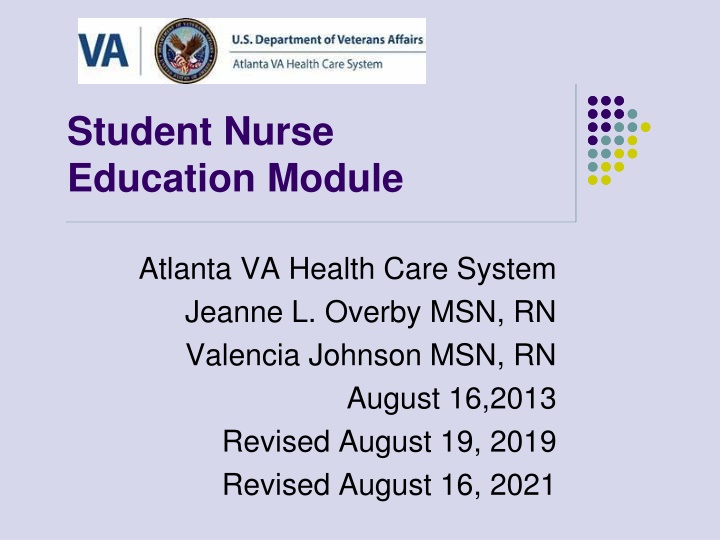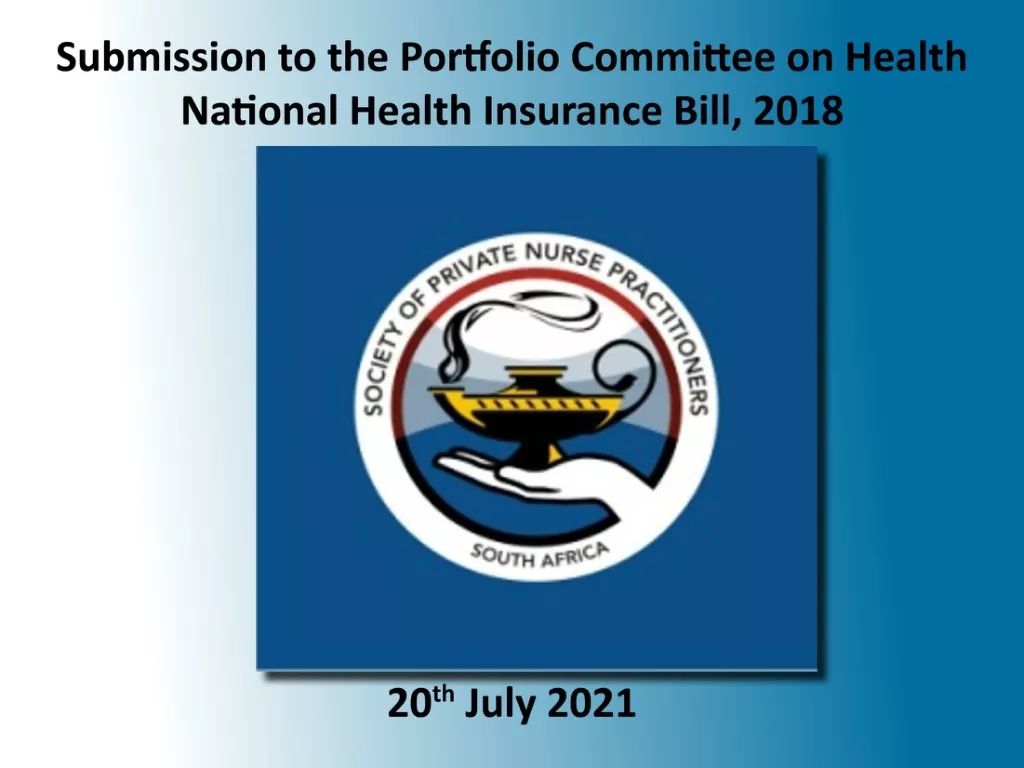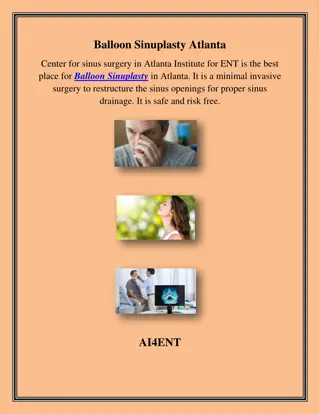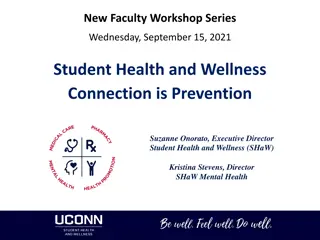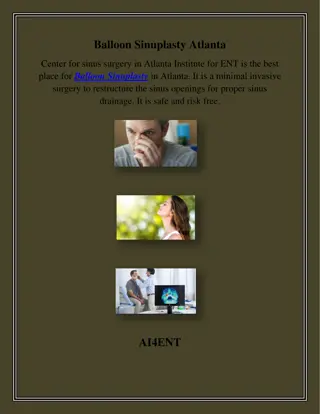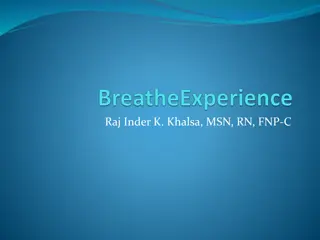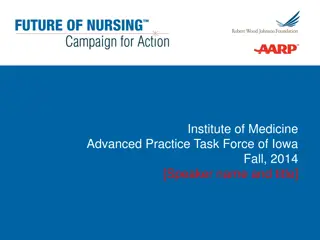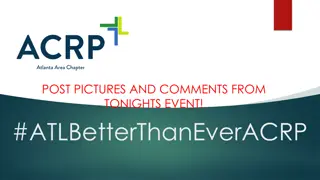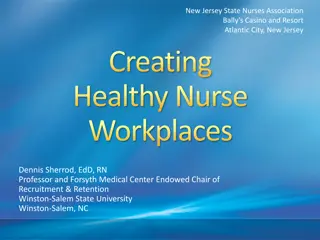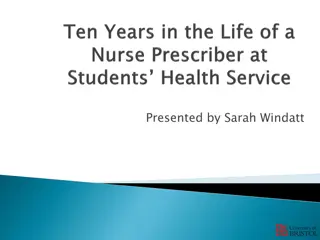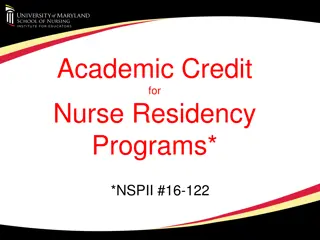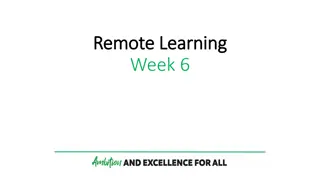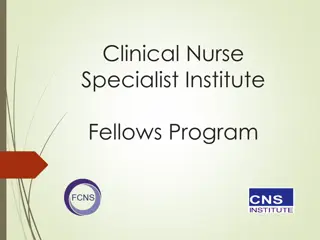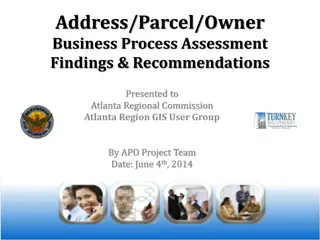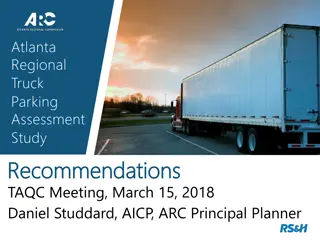Student Nurse Education Module Atlanta VA Health Care System
This module aims to educate faculty and students on policies developed to enhance safety and care for patients within the Atlanta VA Health Care System. It covers topics such as medication administration, patient lifting, cardiopulmonary resuscitation, restraint, and disruptive behavior management.
Download Presentation

Please find below an Image/Link to download the presentation.
The content on the website is provided AS IS for your information and personal use only. It may not be sold, licensed, or shared on other websites without obtaining consent from the author.If you encounter any issues during the download, it is possible that the publisher has removed the file from their server.
You are allowed to download the files provided on this website for personal or commercial use, subject to the condition that they are used lawfully. All files are the property of their respective owners.
The content on the website is provided AS IS for your information and personal use only. It may not be sold, licensed, or shared on other websites without obtaining consent from the author.
E N D
Presentation Transcript
Student Nurse Education Module Atlanta VA Health Care System Jeanne L. Overby MSN, RN Valencia Johnson MSN, RN August 16,2013 Revised August 19, 2019 Revised August 16, 2021
Introduction Goal: to educate faculty & students on policies developed to enhance the safety & care for all patients within the Atlanta VA Health Care System.
Training Outline Module 1: Administration of Medications Module 2: Patient Lifting Module 3: Cardiopulmonary Resuscitation Alert (Code-99) Module 4:Restraint and Seclusion Module 5:Disruptive Behavior (Code-44)
Module 1: Objective By the end of orientation students will be able to describe the safe medication and administration policy at the Atlanta VAMC
Module 1: Medication Administration Nursing students may administer medications under the direct supervision of a clinical instructor or RN preceptor with prior approval Orders are electronically entered via the computer or written on a doctors order sheet. Telephone orders are discouraged; however they shall be written by an RN or pharmacist
Patient Identification Use at Least Two Identifiers When Providing Care, treatment and services The VA uses patient s Social Security Number and birth date
Transcription and Verification of Provider Orders Medication and treatment orders are transcribed electronically or manually by an RN. The RN verifies orders by utilizing the five rights:
Medication Administration Cont d Multiple dose vials must be labeled with a 30 day expiration date once opened Insulin Vials Are Dated For 90 Days After Opening
High Risk Medications Insulin Heparin Parental Nutrition Chemotherapy Concentrated electrolytes
High Risk Medications High Risk medications require two person verification and patient identifiers Validation of Patient Identification, Order, Drug, Dose, or Rate or Rate of IV Infusions, route, and Second Verifier, Shall be Documented in the Barcode Medication Administration (BCMA) System
Intravenous Therapy Students will be allowed to perform peripheral intravenous access with the supervision of a clinical instructor/ preceptor. Access of central venous devices such as arm ports and chest ports will not be permitted by students
Medication Module 1 Summary To improve the accuracy of patient identification To improve medication safety Use at least two identifiers Label and date all medications containers and other solutions (Medication containers include syringes, medication cups, and basins )
Module 2: Patient Lifting Objective: Students & faculty will state the responsibilities and procedures necessary to provide safe transfer of patients with limited mobility at the Atlanta VA Medical Center
Patient Lifting, Contd Patient transfer and lifting devices are key components of an effective program to control the risk of injury to patients and staff associated with lifting, transferring, repositioning or movement of patients
Patient Lifting Contd The transfer team will assist the nursing staff with transferring patients from one surface to another, by using mechanical equipment, patient handling aids and techniques that support a no lift environment and culture of safety.
Patient Lifting contd All lifts/ and or transfer of patients with impaired mobility will require a minimum of two employees, and the appropriate mechanical lift, transfer device or transfer techniques.
Patient Lifting contd Employees are responsible, prior to each transfer/lift of a patient to assess and determine the safest transfer/lift technique appropriate for the patient s functional and mental status.
Patient Lifting contd Employees are responsible for utilizing the appropriate mechanical lifts and transfer devices to comply with policy.
Lesson 2: Summary The education and training of healthcare employees at the Atlanta VA Health Care System is geared towards preventing hazardous injuries in the workplace. The VA enforces the use and the selection of the appropriate patient lifting equipment and devices, as recommended by review of research-based practices of safe patient handling.
Course Review Who can safely lift patients? What is the VA policy on one man lifts? What is the purpose of the safe lifting policy?
Module 3: Cardiopulmonary Resuscitation Alert (Code99) Objective : students will identify the process to call for assistance for Cardiopulmonary resuscitation Code 99 at the Atlanta VA Medical Center.
Module 3: Code-99 Basic Life Support should be initiated immediately when signs of sudden or unexpected death are recognized by personnel trained in Basic Life Support(BLS). A (code 99) can be Activated from the nearest phone by dialing the numbers 204911 and give the operator the exact location and the nature of the emergency which will be Code 99.
Code-99, contd Code buttons are located at the head of the bed in the inpatient areas, the Dialysis unit, emergency room and the observation unit. When the code button is pressed the Code 99 system is automatically activated by the operator who will activate code pagers and overhead announce the Code 99 and location.
Lesson 3: Summary To activate a Code 99 you must Dial 204911 from the phone, or if in-patient area press the button at the head of the bed Code Pagers are carried by all code team members
Module 4:Restraint & Seclusion Objective: Provide Faculty & Students with the policy and procedure, of the Restraint and Seclusion interventions utilized at the Atlanta VA Medical Center.
Restraint & Seclusion The Atlanta VA has strict policies that govern Restraint and Seclusion We are committed to the prevention and reduction of the use of restraints Every effort must be made to prevent situations that can lead to restraint use
Categories of restraints used at Atlanta VAMC MEDICAL/SURGICAL Restraints: Are utilized for acute medical problem, i.e. DT s, electrolyte imbalance, LOC, Promotes physical healing, i.e. need to prevent removal of IV s, O2, ETT, NGT, etc. Behavioral Restraints: protect the individual against injury to him/herself or others, including staff, because of an emotional or behavioral disorder
Restraints contd Behaviors that may need restraints use are: Assaultive behaviors Self abuse Verbalizing or demonstrating intent to do harm to self or others Interference with medical plan of care
SECLUSION SECLUSION- is confinement of a patient alone, and prevents them from leaving for any period of time Seclusion is a form of restraint Seclusion rooms are located on In- patient psychiatric units, and the emergency room
Restraints are not Routine immobilization devices Splints Protective helmets Dressings or bandages Orthopedic prescribed devices Routine methods of care that may involve physically holding a patient during routine procedures
What is a restraint? It is either physical device or chemical that is being used as a means to control the being used as a means to control the movement of a patient movement of a patient.
Restraint Requirements Orders from a Licensed Independent Practitioner(LIP) Atlanta VAMC training Timely assessments and re- assessment of patients Education of patients and families
At the AVAHCS: An RN Can Initiate an emergency restraint /seclusion in an response to a patient that poses an immediate harm to self or others
Module 5:Code 44 Code 44 is called when an individual (patient, visitor or other person) is threatening to injure you, others or themselves and verbal interventions are not successful
When to Call a (Code44) The Atlanta VA uses verbal de- escalation techniques first before calling a (Code44) De-escalation is a technique used during a potential crisis situation in an attempt to prevent a person from causing harm to us, themselves or others (Johnson, 2011)
There are 3 Levels of Intervention for Disruptive Behavior: Level 1 : Non-Emergency Level 2: Disruption that does not respond to verbal redirection Level 3: Disruptive behavior that results in hostile action
Levels 1: Non-Emergency Non-emergency assistance: when an individual s is displaying anger or making threatening comments. Clinical staff role includes: use verbal de-escalation, evaluation by clinical team to assess for mental health consult May choose to call the police for their physical presence and support at ext.204911
Level 2:Code 44 Disruptive behavior that does not respond to verbal redirection is called a (Code 44) 1stResponder Role includes: Dial 204911 and notify the operator of the Code 44 and the location Stay with the individual and assist team when they arrive, provide information and support
Level 3: Code 44 Blue Disruptive behavior that results in hostile action and immediate threat to the physical safety of personnel and others Call Code 44 Blue by dialing 204911 and the police will answer and direct the proper announcement Police secures the individual and limits hostile activity
References The Joint Commission (2022). National patient safety goals: Hospital Accreditation Program. Retrieved https://www.jointcommission.org/standards/n ational-patient-safety-goals/ Administration of medications, Intravenous fluids, by professional nurse, licensed practical nurses and nursing students. Nursing policy #118-3
References United States Department of Labor. (n.d). Occupational Safety and Health Administration: Safe patient handling. Retrieved August 19, 2019, from https://www.osha.gov/SLTC/healthcarefacilities/ safepatienthandling.html Safe Lifting Policy #11-63. Atlanta VA Medical Center
Reference Atlanta VA Medical Center , Memorandum Cardiopulmonary Resuscitation Alert, #11-24.
Reference Atlanta Medical Center Memorandum 11-52, dated May 4, 2016.
References ASIS Healthcare Security Council (2010). Managing disruptive behavior and workplace violence in Healthcare. Retrieved from https://asprtracie.hhs.gov/technical- resources/resource/1947/managing- disruptive-behavior-and-workplace-violence- in-healthcare. Johnson, A (2011). De-escalation strat gies for crisis situations. Retrieved from: http://www.hdsa.org/images/content/1/5/1504 7.pdf.
